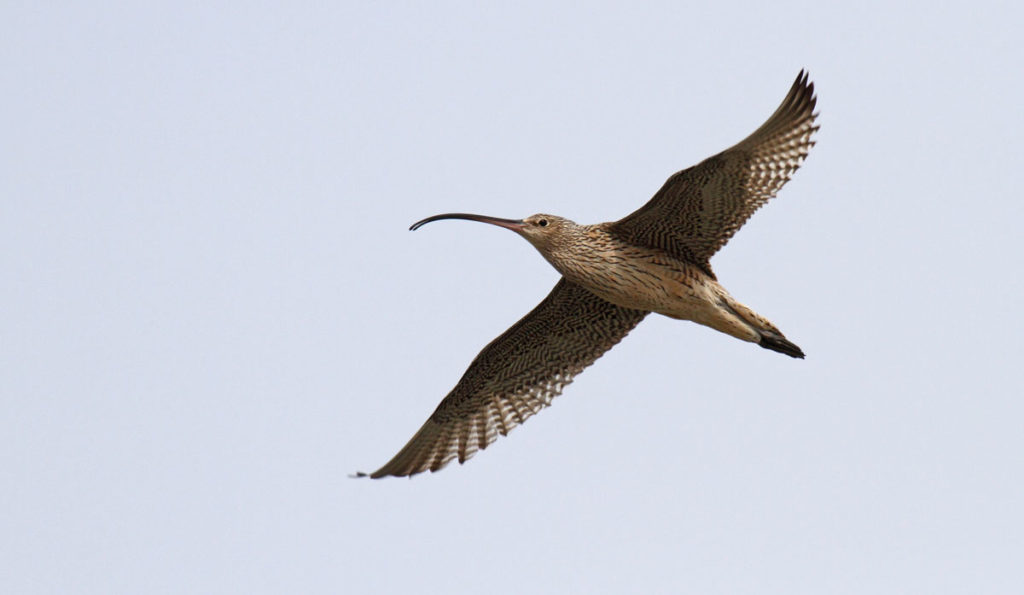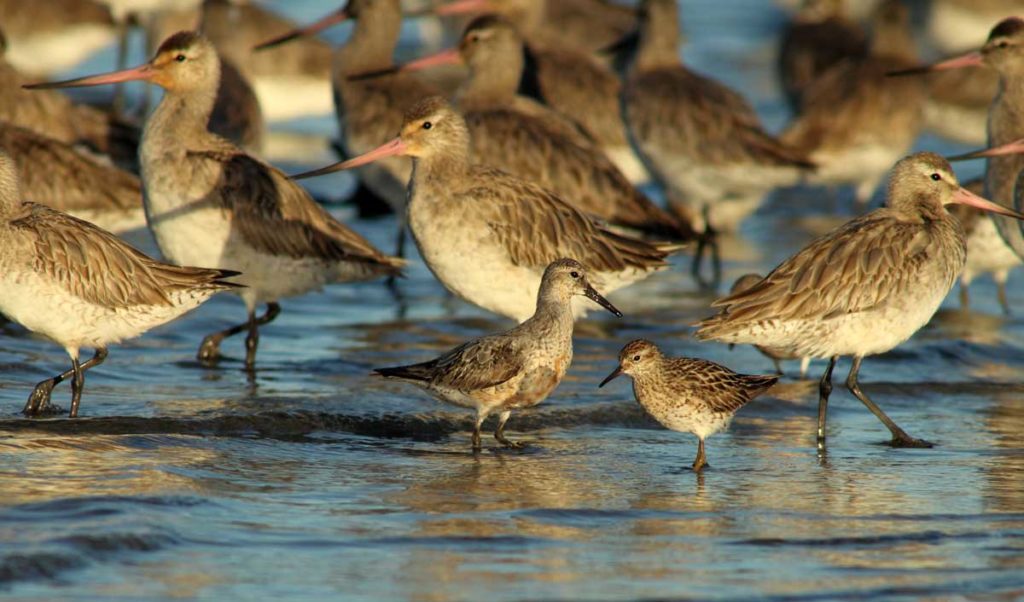Rarely does this newsletter contain articles about the marine habitats of SEQ, understandably given that most Land for Wildlife properties don’t contain them. They are however key attractions for people living in this region. People flock to sandy beaches, go fishing or crabbing in the mangroves and snorkel around coral and rocky reefs of the bay islands.
Of course, the health of Moreton Bay is in-part dependent on the health of our creeks, plus the management of urban and industrial areas. Reducing soil erosion, marine pollution and litter is everyone’s responsibility. Even though the ocean may seem like a long way away if you are in the Lockyer, in effect, most Land for Wildlife properties in SEQ, plays some role in the health of the marine habitats of our Bay.
This article sheds light on one group of remarkable animals who, during summer, call Moreton Bay home.
Moreton Bay Marine Park (MBMP) extends from Caloundra in the north down to the southern tip of South Stradbroke Island and covers 3400km2. The diverse ecosystems of the park provide habitat for a wide variety of wildlife including significant populations of resident and migratory shorebirds. In 1993 the majority of MBMP was listed as a Ramsar site. The Ramsar Convention is an international treaty for the conservation and sustainable use of wetlands and is named after the city of Ramsar in Iran, where the Convention was originally signed in 1971. The migratory shorebirds seen in MBMP use the East-Asian Australasian Flyway (EAAF), which stretches from Alaska and Siberia through East-Asia and South-East Asia to Australia and New Zealand. These birds breed in the northern hemisphere and avoid the boreal winter by making incredible migrations to Australasia.
” A female [Bar-tailed Godwit] was satellite tracked as it travelled 11,690km in a single flight. “

45cm long and a huge 19cm long bill. They eat small crabs and molluscs. As with all
shorebirds, they feed at low tide both during the day and at night. Photo by Todd Burrows
The Bar-tailed Godwit for example makes the longest non-stop journey of any bird species. A female was satellite tracked as it travelled 11,690 km in a single flight over nine days from Alaska to New Zealand. Extraordinarily, the bird totalled 29,500km in a full migration cycle over 174 days. In its lifetime these migrations will take it approximately the distance from the Earth to the Moon!
These journeys are even more remarkable in that the birds are unable to land or feed on the water, increasing the risk of flying across the open ocean.
Approximately 50,000 migratory shorebirds comprising of 30 species utilise Moreton Bay during their non-breeding season (our summer) with some using the area as a staging location before moving further south.

need to refuel (eat) quickly to put back on enough weight to be able to fly back to the Arctic
six months later. Disturbing shorebirds while they eat (low tide) or rest (high tide) can impact
their ability to gain weight quickly. Photo by Todd Burrows.
Birds begin to arrive in late August to September departing from late February through to May. Some immature birds remain in the park during our winter. Most species feed in the zone between high and low tide, foraging over exposed sand bars, mud flats and into shallow water for crustaceans, molluscs, marine worms, insects and other invertebrates. As the high tide approaches they require roosting sites where they can rest and preen. A few species like the Ruddy Turnstone and Wandering Tattler prefer to feed along rocky shorelines.
The migratory shorebirds of Moreton Bay range in size from the large Far Eastern Curlew to the tiny Red-necked Stint and have a variety of bill lengths and shapes. This variation in bills enables species to feed on different prey items at varying depths in the substrate which allows wetlands to support a higher diversity of species. This is evident even within individual species through sexual dimorphism; the female Far Eastern Curlew for example has a significantly longer bill than the male which allows them to seize prey from greater depths.
The survival of many migratory shorebirds along the EAAF is under very serious threat. Long term monitoring in Australia has revealed disturbing declines (up to 90%) in many species. In recognition of this the Australian Government has recently listed the Far Eastern Curlew, Curlew Sandpiper and Great Knot as Critically Endangered under Commonwealth environmental legislation. The next level up on the list is extinct!
In addition the Red Knot and Lesser Sand Plover have been listed as Endangered and the Greater Sand Plover and Bar-tailed Godwit listed as Vulnerable. The Australian Government has fostered individual agreements with Japan, China and Republic of Korea in an attempt to protect these birds along the EAAF. The highly productive Yellow Sea between China and the Korean Peninsula is the critical link between the northern breeding grounds and southern wintering sites for migratory shorebirds of the EAAF. It provides the opportunity for these birds to rest and rebuild body condition before continuing migration.
Despite these individual and international agreements vast areas of intertidal habitats in the Yellow Sea have been reclaimed in recent years destroying critical feeding and roosting areas. The scale of this destruction is hard to comprehend and is the most significant threat to these species. Even in MBMP there are proposed developments which, if approved, would destroy important feeding habitat.
During their time in Moreton Bay birds are trying to increase their body mass to fuel their flights back to the breeding grounds. Shorebirds can lose over 50% of their body mass during their huge migration, so they need a quick and reliable food source to eat as soon as they arrive.
Various disturbances can hamper these efforts and unfortunately for the birds the summer months are also the peak time for recreational users in MBMP. Human-related disturbance is the main problem with people, cars and pet dogs (even horses in some locations) sharing the beaches and mudflats where the birds roost and feed.
Noisy jet-skies and jet-boats can travel on shallow water bringing them close to birds and are especially a problem on high tides when the birds are restricted to a limited number of roosting sites; low flying powered paragliders have a similar impact. Fireworks used adjacent to shorebird habitat also result in significant stress.
What can we do to help migratory shorebirds?
✔ Be considerate of feeding and especially roosting shorebirds, whether you are walking, driving or boating. Domestic animals should be kept under control and well clear of shorebirds. P Reduce marine pollution. The health of shorebird prey is in-part dependent on the amount and quality of sediment flowing into Moreton Bay and much of the rubbish and pollutants that are discarded on land eventually end up in the ocean.
✔ Learn more about them and get inspired by seeing them in the wild. There are a number of good locations to view shorebirds without causing disturbance including the Port of Brisbane, Toorbul, Coombabah Lake and Curlew Island (Gold Coast Broadwater). You will need binoculars or a spotting scope.
✔ Get involved with or support one of the local conservation groups such as the Queensland Wader Study Group (QWSG), Birdlife Southern Queensland and Birds Queensland. QWSG conduct shorebird identification days in SEQ along with regular surveys, counts and banding for monitoring.
Due to the reliance of shorebirds on critical locations along the EAAF it requires the efforts of many countries to protect their future. Hopefully, Australia and Moreton Bay can be a safehaven for these extraordinary birds well into the future.
Article by Todd Burrows
Land for Wildlife Officer
City of Gold Coast

Thank you for the information on these amazing travellers to our shores on the Gold Coast.
Can you tell me what the plan is to protect the shore birds on Curlew Island on the Broadwater would be.
This year being a wetter time has given the birds a reprieve from the boaties taking their dogs over to the island and so the island is like a bird paradise so many species resting and feeding in harmony.